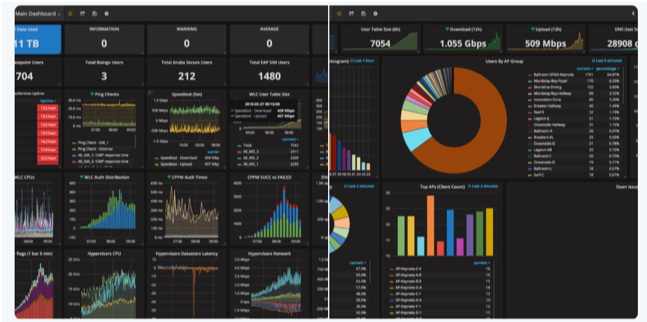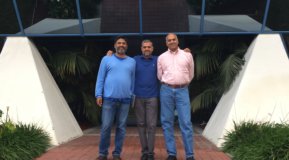We built our own event network to support Atmosphere18 so we could showcase our latest innovations to 3,000 attendees. Showing our vision and our products meant running brand-new software and code that has never been released on a production network. We knew we were taking risks, but also we knew it was worth it.
The event network supported everything—registration, keynotes, product demos, educational sessions, and of course, our attendees. We had detailed plans to install about 50 switches, 250 access points and a cluster of mobility controllers—with a team of seven and in less than 48 hours.
Through the highs and lows, here’s what we learned:
- Be ready for anything. We staged the event network in Sunnyvale to validate our design. When we got to the Mandalay Bay in Vegas, we had some surprises. We pulled the switches out of the boxes and plugged them in, only to discover that a bug in beta code had wiped out the configurations. We viewed the event network as a showcase of how quickly our engineering teams could solve critical issues for customers. They delivered.We also discovered that the documented location of the Ethernet drops in the convention center didn’t always match reality. That meant we needed more switches, longer cables and more time. Fortunately, adding switches was pretty easy, because we used AirWave to create templates and push and manage the configurations. It was a busy 48 hours, but the network was up and running, just in time.
Our grace under pressure was tested during the conference too. A bug in beta software, related to a specific monitoring use case, caused all of our Aruba 7240 controllers to crash. We saw the problem coming hours before, and we were hoping the conference would close for the evening before anything went down. Our team was in the Innovation Zone socializing with attendees when we saw the crash happen on both the AirWave dashboard and our custom NOC dashboard. We ran back to the war room to investigate. Luckily, it was a rolling crash, and each controller in the cluster rebooted a few minutes apart. Because the controllers were clustered, no one even noticed.
We were happier when the NOC dashboard looked like this:

- Be ready for anything. We staged the event network in Sunnyvale to validate our design. When we got to the Mandalay Bay in Vegas, we had some surprises. We pulled the switches out of the boxes and plugged them in, only to discover that a bug in beta code had wiped out the configurations. We viewed the event network as a showcase of how quickly our engineering teams could solve critical issues for customers. They delivered.We also discovered that the documented location of the Ethernet drops in the convention center didn’t always match reality. That meant we needed more switches, longer cables and more time. Fortunately, adding switches was pretty easy, because we used AirWave to create templates and push and manage the configurations. It was a busy 48 hours, but the network was up and running, just in time.
- Get creative when you don’t have total control. And who ever has total control? We worked with the MGM IT staff to get access to the wiring closets during the installation. Then we received a late request—after the MGM IT staff went home for the evening—to supply Ethernet drops for the registration team’s in the Oceanside Ballroom. I knew I had already planned these drops and they should have been ready to use, so why were they requesting them again? Of course, they were having connectivity issues and they didn’t know why. It was a vague problem statement, just like any network administrator receives on a daily basis. We troubleshot it and discovered that the Ethernet drop was patched to a SmartRate port, with a minimum speed of 1Gbps, but the devices only supported 100Mbps. Of course, the problem had to be solved within hours and the MGM staff went home already. Since we couldn’t enter the IDF to change the patch to a 100Mbps-compatible port, we added another switch, which functioned as a media converter.
Another issue we had was with the ISP uplink provided to MGM, then from MGM to us. We paid for a 1Gbps up/down link but never got close to that bandwidth. Additionally, on the first day, the link was constantly dropping and coming back up. We were not happy. How could we provide stable Wi-Fi without a stable uplink? Using our dashboards, we were able to discover the poor uplink performance and provide proof in the form of speed test history to the ISP. The service provider quickly fixed a connector issue on the fiber. - People disappear. People with the best intentions can find it hard to resist 24-hour entertainment in Vegas. I don’t want to name names, but certain volunteer commitments vaporized. There were several long nights for the seven die-hards of the event network team. A huge thanks to everyone who helped out, in both large and small ways!!!
- The user experience was great. We knew we had a tough crowd—our customers and partners (and lots of Wi-Fi nerds), and we designed the network to perform. We expected people to run Wi-Fi speed tests, and with a network that delivered 100Mbps up and down, even in high-density areas like the keynote room. Sweet.
We didn’t really know what to expect with our live experiment of Next-Generation Hotspot and Passpoint. The goal was to make it easy for people to connect their phones to the Wi-Fi, without having to enter new credentials. It worked. A large majority of attendees used the event Wi-Fi, with higher adoption than we have ever seen.
- Event networks are a great opportunity to walk in our customers’ shoes. There’s no substitute for real-world deployments and customer conversations. At Aruba, we believe that our employees in headquarters understand the issues faced by our customers and partners, so we create better products and workflows, from the documentation to day-to-day operations.I fed my experience using AirWave for planning and deployment directly back to the product teams. The ArubaOS team hears our feedback on things like AirMatch, Passpoint and clustering. These are great examples of the value we get by building our own Atmosphere network.
In the end, the sleepless nights were worth it.




